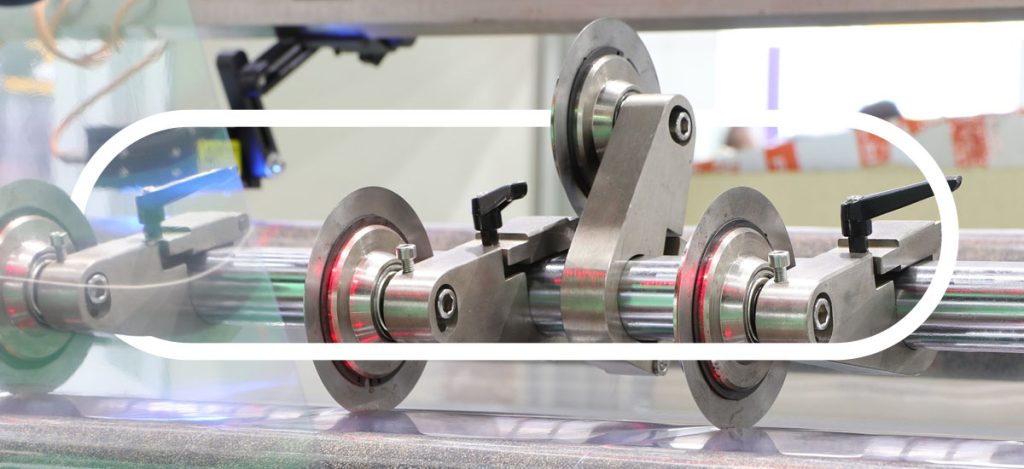
The industrial slitting and converting industry operates under tight tolerances and demanding production schedules. In particular, it’s essential to decide on the right blade material to ensure maximum performance and uptime.
Hardness and toughness are the main factors determining how your blades handle high-output demands. While they sound similar, the difference between blade toughness and hardness can dramatically change your production outcome. Understanding these characteristics and how to balance them helps engineers and buyers optimize performance and value.
What Is Hardness?
Hardness is a blade’s resistance to deformation. Scratching, indentation, and abrasion can all deform a blade, and the harder a blade is, the more it resists wear. This resistance is essential in high-volume slitting operations. In these cases, blades are constantly exposed to abrasives like foils, tape, films and composites. A harder blade will cut better for longer.
The longer a blade retains its edge, the more consistent cuts you get. Higher hardness also translates to reduced blade changes. The result is less money spent on poor cuts or replacement blades. If you’re working with tight tolerances and high output, you could see significant cost and time savings.
However, there’s a trade-off. High-hardness blades might be more brittle, which leads to chipping and failure. Some manufacturers use quenching to create harder blades, where they rapidly cool a hot blade, which traps carbon inside the steel and makes it hard. This process compromises toughness. Manufacturers must find a hardness that performs well without too much brittleness.
How to Measure and Test Hardness
Producers test blade hardness based on a standardized scale. The Rockwell Hardness scale is one of the most common scales for industrial blades. This test uses a steel ball or diamond cone to find the blade’s hardness. The ball or cone is pressed into the blade surface under a load. The indentation depth left in the blade material determines the hardness rating.
Other tests like the Vickers or the Brinell might be used depending on the material, use or desired accuracy. Rockwell is preferred for its speed and reliability. Brinell offers superior accuracy, while Vickers is effective for thin or small objects. Producers will use the test that best suits their product to deliver the most consistent results.
Examples of Hard Materials for Industrial Blades
Blades engineered for hardness have an edge that’s built to last. Some of the most common hard materials for blade manufacturing include:
- High-carbon steel: Materials like D2 and M2 steel offer excellent wear resistance. They’re preferred for slitting foils, films and pressure-sensitive adhesives.
- Ceramic-coated steel: Ceramic-coated steels combine a steel core with ceramic exteriors to create a tough and hard blade. Steel provides toughness, while ceramics deliver hardness.
- Tungsten carbide: This material is extremely hard and rigid. Its hardness means you should avoid using this material in high-impact speed applications. Tungsten carbide is more brittle than steel-based blades.
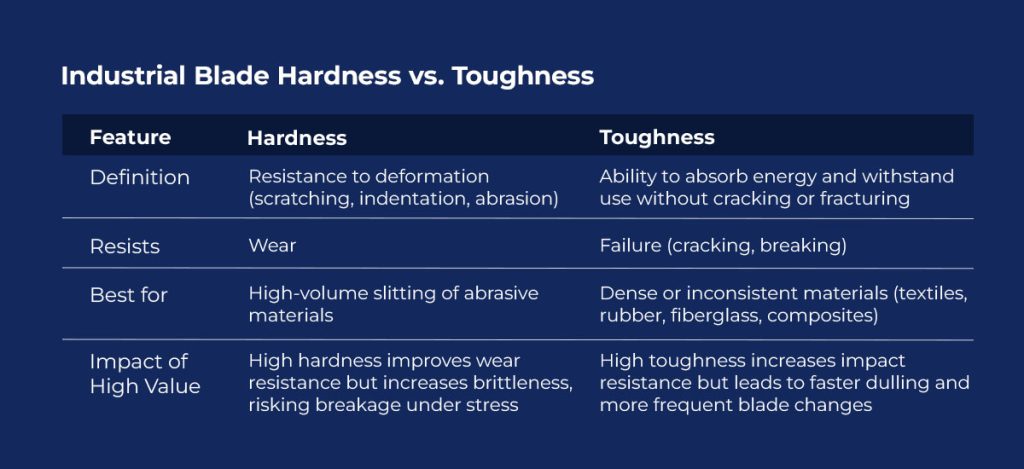
What Is Toughness?
Toughness is a material’s ability to withstand use and absorb energy without cracking or fracturing. Sudden impacts, irregular loads and other heavy-duty use can lead to cracking or breaking. The tougher the blade, the more abuse it can take before it fractures. Essentially, hardness resists wear while toughness resists failure.
Industries with dense or inconsistent materials often need tougher blades. Materials like textiles, rubber, fiberglass or composites are prone to exerting unpredictable forces. They might bunch or embed particles in the blade. Your industrial blade must be able to avoid cracking and chipping. If it’s not tough enough, you risk safety hazards on-site and increased replacement costs.
Tough materials will often lose their edge faster than harder ones. If you’re using a high-toughness knife on abrasive materials, it’ll dull faster. If you’re concerned about downtime or broken tools, it’s often preferable to swap out a tougher blade more frequently.
How to Measure and Test Hardness
Like hardness, toughness has standardized evaluations. Charpy and Izod are the two main testing methods. Both tests involve striking the material with a controlled force. Then, they measure the amount of energy the material absorbs before fracturing. More energy absorbed translates to a higher toughness rating.
It’s common to see the Izod test used on brittle or plastic materials, as it’s the ASTM International testing standard for these materials. The Charpy impact test is preferred for its easy setup, testing and result recording. If you need to test a material for high-impact or you’re working with ductile materials like metal, Charpy is the best option.
Testing might dive further into characteristics like fatigue analysis or destructive testing. These methods deliver deeper insights into quality and come into play for custom blades and challenging applications.
Examples of Tough Materials for Blades
Blades designed for toughness prioritize impact resistance and durability. Materials preferred for their toughness include:
- Carbon steel: Medium carbon steel has excellent toughness. While high-carbon steel has better hardness, medium-carbon steel handles impacts while remaining sharp.
- Stainless steel: Stainless steel is highly durable and corrosion-resistant. They offer easy maintenance and high sharpness.
- High-speed steel (HSS): HSS withstands wear and abrasion. It can retain its edge and sharpness under high speeds and temperatures.
Why Knife Hardness vs. Toughness Matters
Hardness and toughness are trade-offs. There’s no one-size-fits-all product for manufacturers. Your application directly impacts the characteristics you need from an industrial blade. Harder blades might deliver longer edge life, but a tougher blade could withstand impacts longer and prevent breakage.
Consider the following:
- Cutting speed
- Material being processed
- Downtime tolerance
- Expected wear cycle
- Budget
- Quality demands
Blades with the best balance of toughness and hardness might come with a higher cost, but reduced replacement expenses. If your blade has the wrong characteristics for your application, you’ll replace it more frequently and experience increased downtime. Ensure you maximize production efficiency and quality by investing in the right blade qualities.
Many manufacturers can partner with an expert to find an off-the-shelf solution that meets their needs. However, it’s common to need custom blade solutions. With so much riding on blade characteristics, you want to use material that can remain durable, efficient and consistent on the line.
How Material and Application Affect Blade Choice
Hardness and toughness aren’t the only things affecting the blade. The material you’re cutting will influence the blade as well. Different physical and chemical properties matter in industrial blades. You might need to prioritize hardness or toughness depending on these materials:
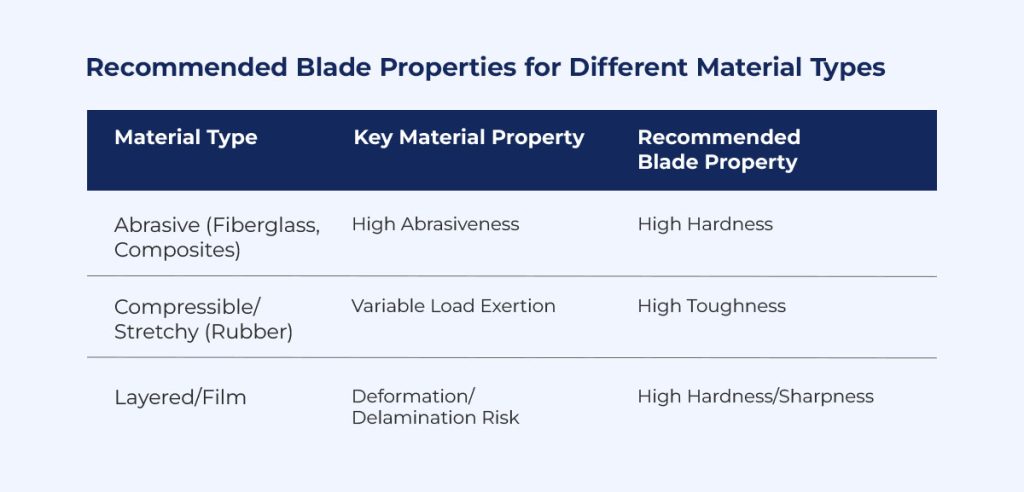
- Abrasive materials: More abrasive materials wear down edges faster. You need a higher hardness when working with materials like fiberglass or composites.
- Compressible or stretchy materials: Materials that stretch or compress exert more variable loads. Manufacturers should use tougher blades to avoid chipping.
- Layered or film materials: These materials might deform or delaminate if the blade isn’t sharp or hard enough. Operations need a blade that can deliver clean slices.
Why Blade Failures Happen
Blade failures can happen to anyone. Sometimes, wear has gone unnoticed. Other times, the blade characteristics are a poor fit for your application. Understanding these common mistakes can help you avoid them when ordering your next industrial blades:
- Application mismatch: If your blade is too hard for the application, it can become brittle and chip. Tougher blades can dull faster when used in high-speed settings. Make sure to match the blade characteristics to your needs to avoid failure.
- Blade alignment: Improper blade alignment can lead to premature failure. Blades need proper securing and positioning to ensure a clean cut and minimal wear.
- Material buildup: Material might build up on the blade. This throws off cutting and can lead to premature wear or blade failure. Clear buildup as recommended to avoid damage.
Blade Hardness vs. Toughness FAQ
Finding the right balance between blade toughness and hardness can be challenging. Here are some answers to common industrial blade questions to help you navigate your options.
Does Hardness Increase Toughness?
No, hardness doesn’t increase toughness. The harder a material is, the more brittle it becomes. Once it’s too brittle, it has reduced toughness. Blade manufacturers must balance toughness and avoid material failure. While a hard blade can stay sharp longer, it might chip or crack if it’s not tough enough.
Can a Blade Be Hard and Tough?
Yes, blades can be hard and tough. However, it takes specific material selection and heat treatment. Some materials are capable of high wear resistance without becoming brittle, but they need advanced engineering to ensure they can perform. Manufacturers might use alloy blending or post-treatment hardening to achieve the desired result.
Does Higher Hardness Mean Higher Strength?
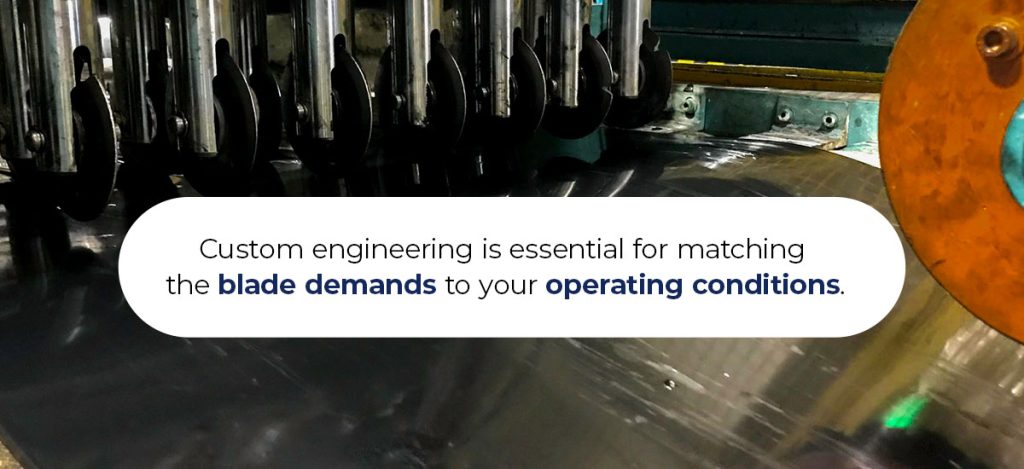
Not always. Hardness is about surface wear resistance, while strength, or toughness, is how well a material resists deformation. A blade that lacks impact strength will break under stress, even if it’s extremely hard. Hardness and toughness also have different contexts for evaluation. Hard blades might hold up under uniform pressure, but fail under vibration. Custom engineering is essential for matching the blade demands to your operating conditions.
How Often Should You Test Blade Hardness?
Testing blade hardness depends on your application and quality control program. High-precision and high-risk operations should invest in more frequent, routine hardness testing. Talk to the manufacturer about their testing frequency and recommendations to avoid using blades with compromised hardness. If your blades are wearing or failing prematurely, look into hardness testing to help your team find the root cause.
What’s the Best Blade Material for Cutting Composites?
Composites are tougher on blades than other materials. They’re often layered and abrasive, with embedded fibers that increase wear. You’ll want to match your blade material to the composite and processing method. Steels like M2 or powder metallurgy blades can work well for composites. They combine high hardness with enough toughness to resist chipping.
What’s the Best Hardness for a Blade?
There’s no best hardness for a blade. The right hardness will depend on your industrial blades’ needs. You’ll have to consider the cutting method, material and downtime. The tougher the material, the higher the toughness you want. If you’re working with thinner materials, go with a higher hardness. Working with an experienced partner can help you find a blade with all the characteristics that fit your operation.
How Does Heat Treatment Improve Blade Performance?
Heat treatment is used in industrial blade manufacturing to improve performance. Manufacturers used controlled heating and cooling cycles to change steel’s microstructure. As the blade undergoes temperature changes, it becomes harder and more wear-resistant. Depending on your goals, tailoring heat treatment can reduce brittleness or increase hardness.
How Intertech Precision Meets Your Application Needs
Intertech Precision offers cutting tools and services designed to meet industrial demands. We engineer our product lines for precision and longevity so that you can focus on the end product. Our main offerings include:
- Standard and custom circular slitting blades: These tools are designed for accurate cuts and come in a range of hardness and toughness ratings.
- Shear cut systems: Our shear knives and blades offer precise cut quality at high speeds.
- Pneumatic knife holders: These devices hold and position slitting knives. Our holders are compatible with all PQAS-style holders. You can use our knife holders for accurate pinking, score slitting, perforating and crush cutting.
- Helios: Helios systems cut flexible materials into sheets or reels. These solutions come in manual or automated options to fit your application. They also offer retrofitting, modifications or new solutions for the best possible result.
Intertech Precision also delivers custom blade solutions engineered for your operation. Our consultations help us understand exactly what you’re looking for. What materials are you processing? What speeds and pressures are involved? How critical is impact resistance compared to edge retention? From there, our team recommends steel grades, blade geometry and coating.
We offer a wide range of cutting and slitting products and services. From custom slitting and blade design to lapping and surface regrinding, we have the tools and expertise to help you optimize your manufacturing.
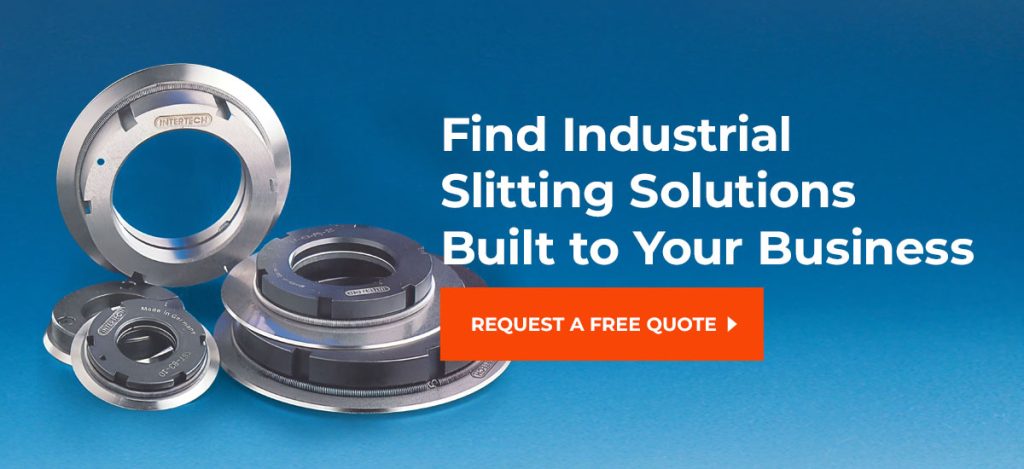
Find Industrial Slitting Solutions Built to Your Business
Getting a blade with the hardness and toughness you need takes skill and experience. Navigating industrial blades alone could leave you with a safety hazard and poor production quality. With over 70 years of experience, Intertech Precision specializes in industrial blades for slitting. We can provide you with custom solutions designed to reduce downtime and deliver cleaner cuts.
As a business trusted by leading manufacturers like 3M and Goodyear, we bring an experienced, personalized, engineering-first approach to every project. We’re here to solve your complex cutting challenges with precision and expert support. Reach out to our team today for a free quote. Let us show you how the right blade can improve your process and deliver better returns.
